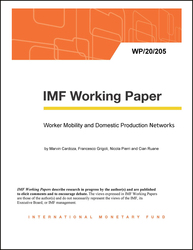
Worker Mobility and Domestic Production Networks
Worker Mobility and Domestic Production Networks
READ MORE...
Volume/Issue:
Volume 2020
Issue 205
Publication date: September 2020
ISBN: 9781513557724
$5.00
Add to Cart by clicking price of the language and format you'd like to purchase
Available Languages and Formats
| English |
Prices in red indicate formats that are not yet available but are forthcoming.
Topics covered in this book
This title contains information about the following subjects.
Click on a subject if you would like to see other titles with the same subjects.
Exports and Imports , Labor , WP , production network , connected firm , firm pair control , worker flow , origin firm , hiring firm , dummy variable , buyer-supplier relationship , Labor mobility , Wages , Productivity , Human capital , Trade balance ,
Summary
We show that domestic production networks shape worker flows between firms. Data on the universe of firm-to-firm transactions for the Dominican Republic, matched with employer-employee records, reveals that about 20 percent of workers who change firms move to a buyer or supplier of their original firm. This is a considerably larger share than would be implied by a random allocation of movers to firms. We find considerable gains associated with this form of hiring: higher worker wages, lower job separation rates, faster firm productivity growth, and faster coworker wage growth. Hiring workers from a supplier is followed by a rising share of purchases from that supplier. These findings indicate that human capital is easily transferable along the supply chain and that human capital accumulated while working at a firm is complementary with the intermediate products/services produced by that firm.
Copyright © 2010 - 2024
Powered by:
AIDC



